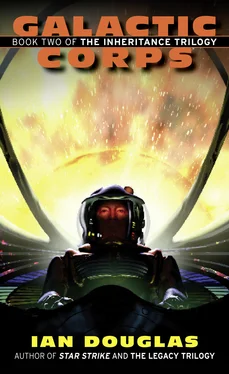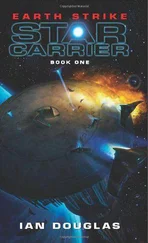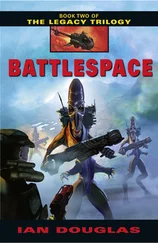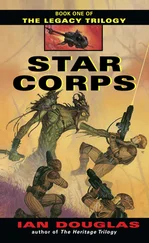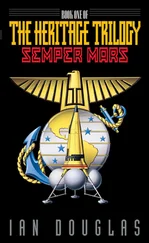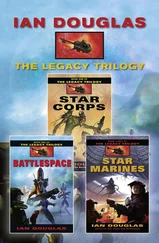Laser fire snapped across the outer hull of Garroway’s pod, generating a silvery puff of expanding vapor. Damn! The Xulies weren’t supposed to be able to see the Marine bottles with the optical benders on … but, then, no one was certain what wavelengths the Xul warriors used for vision, or what other senses they might possess.
He snapped off another burst of nano-D in response, but the Xul that had nailed him had already vaporized an instant before, caught by a flash from Sergeant Colby’s plasma gun.
“Thanks!” Garroway called to her over the tactical net.
“Don’t mention it, Gare!” was her response. She was already tracking another Xul warrior, as was Garroway. As the enemy swarmed over the Marine position, he’d switched to single shots and shoot-to-hit; the enemy was widely enough dispersed now that the Marines could no longer wipe out large numbers of the enemy combat machines with area fire. His bottle spun wildly, tracking a Xul as it streaked past low above the surface of the fortress. Garroway held his fire until his targeting cursor tracked past several nearby Marine bottles, then slammed a nano-D pod squarely into the now-fleeing machine from behind. The Xul warrior fell to pieces, a spray of dissolving parts, seconds later.
Local nano-D levels were rising sharply in the immediate battlespace. Drifting motes of disassembler were striking his pod, now, then rebounding. They were programmed to recognize the outer nano coatings of the M-CAPs and ignore them and seek other targets, but a few were beginning to burrow into his bottle at points scoured clean of nano by the Xul laser bursts. The automatic defenses on Garroway’s pod were growing erratic, and would soon fail.
“Smedley!” Garroway called, loosing another barrage at a pair of incoming Xul combat robots. “I’ve got nano-D on my pod, friendly fire! Tell the bastards to go chow down on something else!”
The company AI tweaked the electronics in Garroway’s bottle, and the errant nano-D drifted away into space like a puff of vapor, repelled by the brief, coded signal. A lot of the stuff was starting to work on the Xul fortress’s hull around the bottles, too. That might cause problems later, but there wasn’t much that could be done about it. Modern battlefields tended to soften and sludge down as random traces of nano-D, both friendly and enemy, began to accumulate in the area.
Then there was a sharp jolt, and Garroway’s bottle dropped by a meter, sliding down hard into the boarding collar. The deck he was standing on dilated open. He didn’t immediately fall in the microgravity of the Xul fortress but, setting the pod’s combat initiative on auto, he triggered a pair of battlespace drones, launching them into the emptiness at his feet.
A firefight was raging down there, as other Marines entered the enemy bastion. Garroway’s drones uplinked to his helmet, showing him images of Marines in heavy armor struggling in a low, broad passageway with Xul fighterbots coming at them tentacle to metallic tentacle. He charged his suit’s weapons, then gave a hard shove down through the open deck. Passing through the boarding collar, he entered the fight.
The passageway was two meters tall and ten to twenty wide, and the Marines were forced to stoop slightly because a Marine in Type 664 combat armor stood at nearly two and a quarter meters.
It was a Dantean scene, a circle of Hell, with Marines and Xul fighterbots struggling at knife-fighting range. It looked as though it should be unbearably noisy, but the interior of the Xul fortress was in hard vacuum and each bolt of plasma, each detonating grenade, each ripping or exploding alien shell did so in eerie silence. When Garroway’s boots touched the deck, though, he could feel the noise, a kind of steady, pounding thrum in the bulkheads and deck as the vibrations were transmitted through Xul ceramic to his combat armor.
The one advantage possessed by the Marine assault team was that they were physically shorter than the Xul machines, which, in that low corridor, were coming at them horizontally, pulling themselves along with powerful flicks of their tentacles against the deck and the overhead. As a result, the only weapons the enemy could bring to bear were those set into the tops of their egg-shaped bodies. After a few moments, the Marines, too, began leaning forward, lifting their boots off the deck, dropping prone to minimize their cross-sections as targets as they poured a devastating and concentrated fire into the attacking hordes.
Garroway mounted an MPPG-40 on the right arm of his combat armor, a rapid-fire mass driver on his left. He shouldered forward about twelve meters, taking up a firing position next to Corporal Gerad Kukovitch, a massively built fungie in the company from Spokane, Washington. Kuk was mounting a 20mm full-auto grenade launcher on his suit; he was one of the few people in the company big enough to pack one. The Marine was floating horizontally, taking partial cover behind one of a number of pillar-like structures scattered through that alien hall. They looked like massive, meter-thick bundles of rope or ceramic cabling growing like tree trunks between deck and overhead. Garroway stretched out beside him, firing from the other side of the pillar.
Side by side, the two Marines coordinated their fire, ’Vitch’s grenades silently flashing as they ripped through the enemy ranks, Garroway’s MPPG sending blinding bolts of blue-white energy arcing down the corridor, ripping deep into everything they touched. Sergeant Larissa Colby joined them a second later, adding her plasma weapon to the melee. One by one, other Marines began locking in with the growing phalanx of Marines while their suit AIs linked in with one another under Smedley’s guidance to coordinate their fire.
Together, as a unit, they were far more effective in concentrating their fire.
And then, almost magically, the enemy horde vanished, seeming to melt away into deck, overhead, and the far bulkheads of the chamber.
“Keep alert!” Captain Black called over the company Net. “They’ll be back! Special weapons forward!”
Two Marines moved up the debris-filled space, hauling massive tubes with them. Tripod legs unfolded as they planted the mounts against the deck and activated them.
For some centuries, Marine tactics against Xul ships and bastions had involved boarding the enemy and lugging backpack nukes into the structure’s depths. Nuclear explosions on the outer hull of one of the immense Xul hunterships or the even larger enemy fortresses did little permanent damage, and the resultant craters generally were patched over within a matter of minutes by flying clouds of fist-sized repair robots. A nuke detonating deep inside a Xul ship, though, tended to cause terrible damage, hampered automated repair efforts, and often loosed the microsingularities these monsters used as their power sources, and that was almost always fatal even to the largest Xul ship or structure.
Backpack nukes had been standard Corps issue until a few years ago. Now, however, the Marines had something a little better in their arsenal. …
1506.1111
First Platoon, Bravo Company
Cluster Space
0635 hrs, GMT
“Enemy targets bearing ahead and behind,” Smedley reported in maddeningly calm tones.
“Here they come again, boys!” Captain Black warned. “Let ’em have it!”
“Ooh-rah!” Second Lieutenant Cooper yelled over the Net. “ Kill the bastards!”
The defenders of Xul ships and bases tended to act and react in predictable ways. Assaults were en masse , wave attacks with thousands of units moving forward as one in an attempt to overwhelm Marine perimeter defenses. Once the Marine defenders had killed enough of the oncoming Xul combat units—estimates suggested the number ran around twenty-five to thirty percent of the total number of the attackers—the remainder would break off and disappear, usually by vanishing back into the walls of the structure’s interior passageways and compartments. Some minutes would pass while the Xul built up their numbers once again, bringing in fresh combatants from deeper inside the target, and then the assault would be renewed.
Читать дальше
